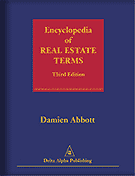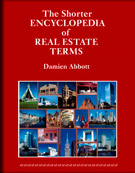
ISBN 978-0-9668946-4-6
£72.50/ US$115.00/ €87.00
Order securely online with

Subscribe
or take a 15-day Free trial

ISBN: 978-0-9668946-1-5
£15.00/ US$22.50/ €18.00
Order securely online with

ISBN: 978-0-9668946-2-2
More New Real Estate Terms
Fee Tail
A 'fee cut down'. An 'estate tail' or entail, i.e. an interest in property (real or personal) that is limited as a right of inheritance to lineal heirs. A fee tail is similar to a life estate in that it is granted for the life of the first generation, but it then automatically to the next generation (generally the eldest male), and so on, until the family line dies out and then it reverted to the grantor or the grantor's successor. A fee tail is a freehold, i.e. it is an estate of inheritance that may last forever, but it passes to a specified line of heirs, unless or until that line dies out. A fee tail may be limited to the 'heirs of the body', all 'issue', or certain issue; but not to all heirs (collateral and lineal), otherwise it would be a fee simple. "The expression fee tail or feodum talliatum, was borrowed from the feudists … among whom it signified any mutilated or truncated inheritance, from which the heirs general were cut off", 2 Bl Comm 112n. (Strictly, the line of heirs is called the 'entail'; the land is said to be 'entailed'; the estate is an 'entailed estate'; and the holder of that estate is the 'tenant in tail'.) A fee tail may be unlimited passing to any lineal heirs of the grantee—'tail general'; it may be limited to the one or specified heirs of the body, such as from a particular marriage—'tail special'; also a tail general or a tail special may be limited to the male heirs only—'tail male', or to the female heirs only—'tail female'. ('Fee tail' is used frequently as synonymous with an entailed interest; however a fee tail was a form of legal estate in land that existed in English law prior to 1925 and was abolished as such by the Law of Property Act 1925, s. 1. The term entailed interest is now used in English law, as it was in the LPA 1925, s. 130(1)—although that section has been repealed). In English law, since 1 January 1997, no new fee tail interest can be created and if an attempt is made to create an entailed estate the property is held in trust absolutely for the person to whom the property was purportedly granted (Trusts of Land and Appointment of Trustees Act 1996, Sch. 1, para. 5). Thus, if A transfers a freehold to B in fee tail, B receives a fee simple absolute in possession and, if B is an adult, he can call on the trustees the transfer of the absolute title. Also, if A grants a freehold to B for life, remainder to C in fee tail, a trust of land arises so that B has a life interest and C has a fee simple in remainder. In the US, 'fee tail' or 'estate in fee tail' is a more common term than entailed interest or entail. An estate in fee tail "is created by an otherwise effective conveyance which (a) is made in favor of a natural person as to whom the conveyance contains words of inheritance; and (b) in specific words confines the succession to the issue of the first taker or to a designated class of such issue", The American Law Institute, Restatement of Property (St. Paul, MN: 1936), § 59. The estate of fee tail has been abolished in nearly all jurisdictions, having been converted into a fee simple or 'fee estate'. Alternatively, in a few jurisdictions, the first taker of the estate receives a life estate, with any subsequent heir automatically receiving a fee simple, or if there is no heir, the estate reverts back to the original grantor as a fee simple upon the death of the first taker. In most of the other jurisdictions that still recognize a fee tail, the holder of that estate may bar the fee tail by simply conveying a fee simple estate. In the US, sometimes called an 'estate tail', an 'estate in fee tail' or a 'tenancy in tail'. See also base fee, conditional fee, remainder. 28 Am.Jur.2d., Estates (Rochester, NY), §§ 48–58. J.E. Cribbet et al. Cases and Materials on Property (8th ed. Westbury, NY: 2002), Ch. 14, Sec. 4 'The Fee Simple Conditional and Fee Tail'. J. Dukeminier & J.E. Krier. Property (Casebook series) (4th ed. Frederick, MD: 1998), pp. 205–9. 2 Powell on Real Property (Albany, NY: ©1997- ), §§ 196–198[1]. 2 Thompson on Real Property (2nd ed. Charlottesville, VA: ©1994- ), Ch. 18 'Fee Tail'. P. Butt. Land Law [Australia] (6th ed. Pyrmont, NSW: 2010), Ch. 9 'The Fee Tail'. Anger and Honsberger: Law of Real Property [Canada] (2nd ed. Aurora, ON: 1985), Ch. 6 'The Estate in Fee Tail'. Megarry & Wade: The Law of Real Property (7th ed. London: 2008), §§ 3-006, 3-078—3-091. See also Appendix B, Historically Significant English Statutes, De Donis Conditionalibus.
Terms in bold are defined elsewhere in the Encyclopedia.
Further explanation of the style of reference material is provided in the
User Guide (available to subscribers)
bibliographic references:
More New Real Estate Terms
© Delta Alpha Publishing 2025
